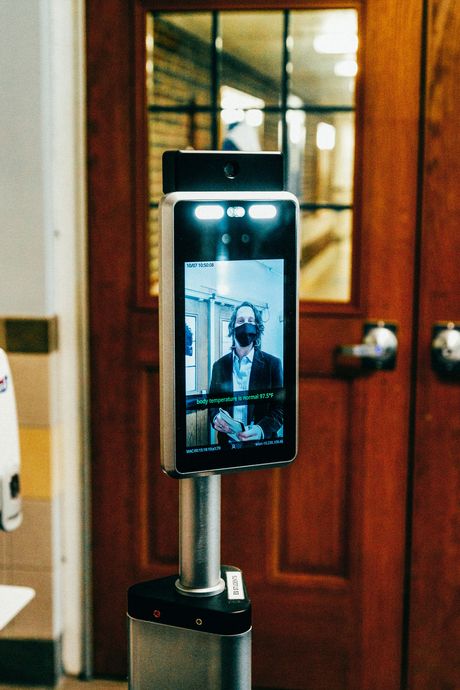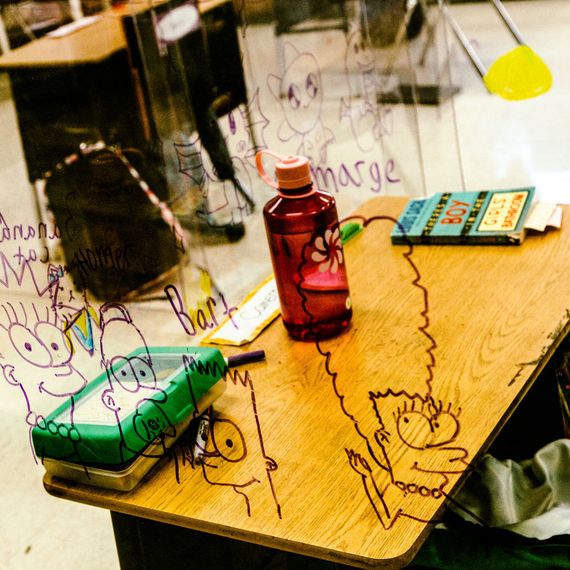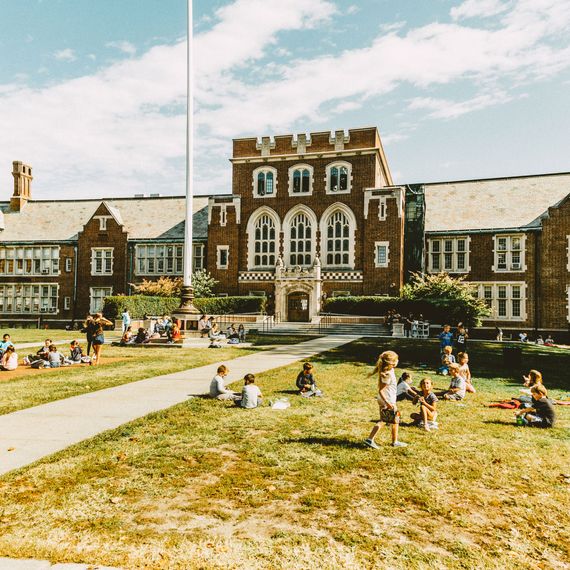
In the expansive cafeteria in Grafflin Elementary School, in Chappaqua, New York, with its double height ceiling and stage on its far side, Carol Scappaticci extended a microphone rubber banded to the end of a yardstick in front of a student. Scappaticci, a fourth grade teacher, likes to slalom among desks in her unusual classroom this year with this homespun tool. Without it, and a set of towering speakers, her twenty students have trouble hearing each other when they share questions or comments. Other general education classes in Grafflin are similarly fanned out, in the school’s library and gymnasium.
Standard-sized rooms, for music, art, and makerspaces, were also stripped of their original purposes, and commandeered for regular classes that are now split between two rooms, roughly ten children, amply spaced, in each, with a teacher and an aide shuffling between them. Giant monitors at the front of every room enable the kids to see, and fumblingly interact with their classmates next door, and those who’ve opted to work remotely from home.
Chappaqua is among a small minority of districts in the New York metro area with students attending school full time, and Grafflin, along with the other elementary and middle schools in Chappaqua, has undergone an extreme makeover to operate at full capacity and keep everyone socially distanced.
I visited Grafflin one day in early October, where I was hosted animatedly by Christine Ackerman, Chappaqua’s superintendent. At 8:45 that morning Ackerman, tall and slim, in a fitted black pantsuit, greets me on the front sidewalk. We watch children arrive on a procession of buses, each outfitted with a dash-mounted infrared thermometer ready to deny entry to any child with an elevated temp. I see classrooms with modular desks in strange shapes that fit together in pre-pandemic times for collaborative learning, but now are broken apart like an exploded puzzle. We pass a little boy crying in the hallway. A faculty member is soothing him by rubbing his back. It’s not exactly social distancing. But would orbiting a distressed child by six feet be humane? Another warming touch: most of the staff have large buttons affixed to their shirts featuring smiling photos of themselves so children can envision the adults’ faces behind their masks.
On a large athletic field white dots are painted in a grid as marks for 75 students in phys-ed class. Music is blaring. It’s 64 degrees, the sky is royal blue, and there’s just a hint of autumnal rot in the air. “Our parents are so grateful,” Ackerman says as we gaze at the children dancing in place then, as some sort of exercise or game, one by one running down the aisles of their peers.
Seven months after New York went into PAUSE, this vision of full-time in-person school seems like a fantasy. We’re used to seeing photos of masked kids in European and Asian classrooms, but not here in New York. Space constraints, population density, school finances, parent and teacher fears, lack of guidance from state and federal government — a seemingly endless list of justifications have kept most American kids out of their schools full time.
But a small number of metro area public schools in New York have decided to bet on full-time-in-person education. Among 40 districts in Westchester, roughly the entire public school system in the county, four districts are running full time in person (FTIP) for kindergarten through eighth grade; three districts are doing so through fifth or sixth grade. Notably, children in nearby towns, many of which have similar socioeconomic demographics as the districts with FTIP schools, are generally only in school a fraction of each week.
According to my analysis of the 40 districts’ learning models and the state’s “COVID-19 Report Card,” there are 8,801 students and faculty attending or working for full time programs in Westchester public schools. Of those 8,801 students and faculty, there have been four COVID-19 cases since the beginning of the school year, or 0.04 percent. Among the approximately 155,162 students and faculty not participating in FTIP school, there have been 97 cases, or 0.06 percent.
It’s become a platitude that “we all want children to be in school.” Yet considering the case rate for hybrid and remote learning is two-hundredths of a percent higher than it is for FTIP learning (which a number of experts months ago had warned could happen), in Westchester, and the regional positivity rate has been hovering around 1% for months, why have so many districts been unable to achieve this aim, and how are the successful ones doing so?
I visited public schools in Chappaqua and Bronxville, both of which are operating kindergarten through eighth grade full time in person, to try to find the answer.



About 25 minutes south of Grafflin Elementary, down the Sprain Brook Parkway, lies Bronxville, a village that comprises just one square mile. All three of its schools are unified in a massive, Collegiate Gothic complex that, viewed from the front lawn, could easily sub for an elite British boarding school. As I entered the building my body was scanned and recorded onto a video monitor that displayed “body temperature is normal 97.5℉” across the bottom of my image like a cable news chyron.
Bronxville’s superintendent, Roy Montesano, trim, in a light gray suit that matches his light gray Bronxville logo’d mask, greets me, and, noticing me marveling at the monitors, says, “they can track 40 kids a minute.” Like Chappaqua, classes in Bronxville have overtaken the gymnasium and multipurpose rooms. Except here floor-standing Lucite type barriers encase each student. Many of the barriers are personalized with taped-on pictures, not unlike cubicles in offices, though I spot a few with doodles of Simpsons characters and flowers, graffiti style, directly on the plastic.
Bronxville also split classes between regular rooms, so fewer children are in each classroom at any one time. As we peek in on one of them a history teacher in a Mondrian-patterned mask waves hello. The building’s cafeteria remains open. Children sit at communal tables eating baloney sandwiches and granola bars, while Montesano leans down to chat with them. Aside for the masks on the staff, it feels like an alternate reality from 2019.
Throughout my time at both schools I couldn’t help but feel pangs of exquisite envy. Children, in school, full time! Due to several weeks of a remote start, extended closures for two cases she had no direct contact with, and a schedule that, remarkably, designates every Wednesday for no classes at all – in person or remote — my sixth-grade daughter had been in school a total of two days this school year. My fourth-grade son is in each day, but for two hours and 20 minutes, less time than when he was in nursery school. Even seeing Bronxville’s clear, hard barriers was a sore point. In my children’s district the barriers, flimsy cardboard and plastic, improbably, and cruelly, are opaque on the sides, not unlike horse blinders. I recognize, of course, that children in other districts where there has been zero in-person instruction are even worse off.
Chappaqua and Bronxville are both affluent areas, and, to some extent, money explains why they’ve been able to run full time and other districts have not. In addition to sizable budgets, they have robust foundations funded by parents to pay for extras, such as $40,000 for antimicrobial film on high touch surfaces in Bronxville. In the Byram Hills district, in Armonk, where K–6 are in full time, its foundation purchased ViewSonic monitors (interactive white boards) so a teacher’s writing on a screen in one room is mirrored on a screen for the split class next door.
But it’s incorrect to pin money as the sole determining factor of whether a school can have kids there full time or not. Scarsdale, Rye, Mamaroneck, Irvington are all extremely wealthy towns, surely each of which have extensive fund raising capabilities among the parent communities, yet none of them have school full time. Conversely, Hendrick Hudson and Somers, where median home prices are less than half that of the aforementioned towns, are operating kindergarten through fifth and sixth grade, respectively, full time.
To staff all those split classes, Bronxville was able to use teacher residents (akin to student teachers), a portion of which had already been employed by the district. But they are paid $85 a day, totalling around $135,000 for the year for all of them, a tiny line item in a $50 million budget. They also are used as substitute teachers, cutting some of that expense. In utilizing specials rooms, Chappaqua not only gained space but also, in practice, gained staff members. “The art teacher, for example,” Ackerman explained, “while on site, will teach a whole grade at one time through Zoom. That frees up the rest of the teacher’s day to be a monitor or alternate teacher in a split classroom.”


Bronxville doesn’t have teacher residents in its middle school so the administration “had to be creative” there, Montesano explained. They knocked down walls in smaller rooms, and ripped out and carted away bookcases, file cabinets, and other furniture to make more space. “We took out about basically everything that wasn’t a desk,” he said. Then they swapped in older desks that are smaller, sometimes just college style chairs with tablet arms. They used auxiliary space in the library, and had the teachers rotate while kids stayed in their rooms in cohorts.
To be clear, regardless of their finances, some districts have more prohibitive space constraints than others. And, relatedly, population density also varies from one building to the next.
But this type of planning, ingenuity, and initiative makes plain an essential determinant for why certain districts, with the necessary resources, have full-time in-person schooling: the will of the leader.
“I know those sixth graders hadn’t been in school for a long time,” Jen Lamia, Byram Hills’s superintendent said, explaining why she pushed so hard for her district to run full time through sixth grade. “I didn’t believe they had the disposition to learn remotely. I knew they needed to be in the room.”
“In the summer we saw that the science is telling us young kids are less likely to be infected,” Bronxville’s Montesano said, “so we started figuring out how to get K-2 in full time. Then I thought, ‘What about K-5?’ Then K-8. We saw this as a problem to solve.” Montesano is so committed to getting kids into school that even half-time hybrid for high school wasn’t satisfactory. He recently implemented a new schedule, putting his high schoolers in the building two-thirds of the time. “Anything I can do to safely get kids, all kids, into school as much as possible, I will do.”
Ackerman’s team in Chappaqua started buying PPE and contracted for air filtration work back in April. “We had all that in place at the end of last school year, even though official guidance wasn’t released until July.” “We brought in faculty over the summer to work with us,” Adam Pease, Chappaqua’s assistant superintendent for curriculum, told me. “Our attitude was, ‘We need as many kids in school as safely possible,’” he said. “So we prepared models. Christine would not take no for an answer.”
In August, after the FTIP plan was announced in Chappaqua, teachers there held a motorcade rally advocating for a remote-learning-only start to the school year. “I didn’t blame anyone for feeling apprehension for returning,” Ackerman said. Nevertheless, she pushed ahead with her plan.



An enormous weight has been dropped on school administrators. Andrew Cuomo, New York’s governor, said that if the positivity rate was below five percent using a 14-day average, schools were merely allowed to open. Cloaked in language of community autonomy, Cuomo punted, leaving every superintendent on their own to make decisions about opening and, when cases inevitably arise, decisions about closing. In the absence of a requirement to open full time, it was obvious from the get-go that the vast majority of superintendents were going to choose what they perceived to be the most cautious path.
“If there was a mandate from the state that would have made things so much easier,” Montesano said. “Superintendents are not health officials, yet we’ve been tasked with making health related decisions.” “I understand why some superintendents weren’t able to do this,” Lamia, of Byram Hills, said. “It’s not surprising so many defaulted to a conservative approach because the guidelines have been so vague, and at times contradictory.”
Indeed, many of the administrators I spoke with in the 40 districts cited their schools’ inability to adhere to the state’s six-foot distancing guidelines as a reason why their students weren’t in school full time. Yet the New York Department of Health guidelines state that schools need to maintain six feet of distance between students “or” use barriers.
Joe Ricca, the superintendent for White Plains, a district that’s exclusively in a hybrid model, said he looked at the recommendations from the American Academy of Pediatrics and the World Health Organization, both of which say that three feet of distance is sufficient, and was aware of the state’s allowance for maintaining less than six feet of distance, but that he had to meet what he perceived to be the interests of the teachers and community. “There’s no way the board of education or I were going to choose the less conservative option.”


Considering the public and political pressures, it’s a predictable calculation, but not without its own costs. “From the beginning we were very worried about the harms inflicted on our kids by keeping them out of school,” Montesano said. “At the end of last school year, our psychologist told us that anxiety among the kids was sky high.” The massive learning gaps, which impact underprivileged children the most; costs to future earnings; physical harm from extreme sedentary behavior associated with prolonged screen time; and psychological damage seen as rises in depression and loneliness from being kept out of school and removed from regular interaction with peers are all well documented. Hybrid and remote schedules are also deeply inequitable for families that don’t have a parent who can provide childcare.
Governor Cuomo, for months, has said that we must “follow the science, follow the data.” Following the science means adapting our responses to what we’ve learned so far. My findings for Westchester’s minimal school case rates are not an anomaly. Recent data, from Brown University economist Emily Oster, on nearly 200,000 schoolchildren, in 47 states, showed a confirmed COVID-19 infection rate of 0.19 percent among students and 0.65 percent among staff who have been in school full time at full capacity.
This isn’t to say there won’t be cases, or even clusters in New York schools. Still, in light of the evidence, it’s hard not to conclude that there has been a misjudgment by most administrators about what’s conservative and what’s risky all along. “I do believe that kids are safer in school. We’re controlling that environment,” Montesano said. “I look at the decision and firmly believe it is right. Do I worry every day? Yes. But I’d have that same worry if there were half the kids here.”































